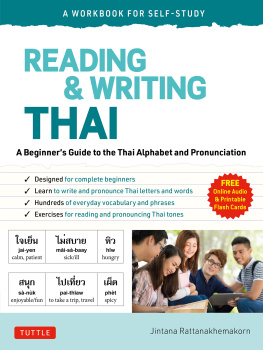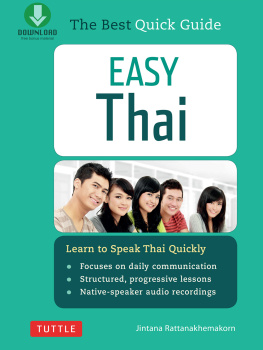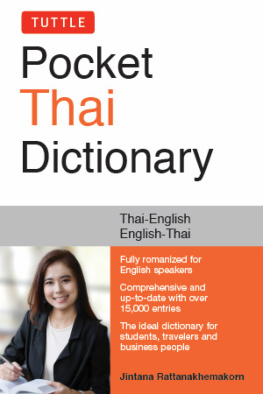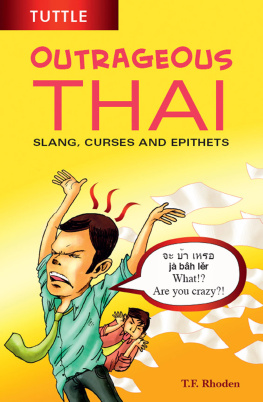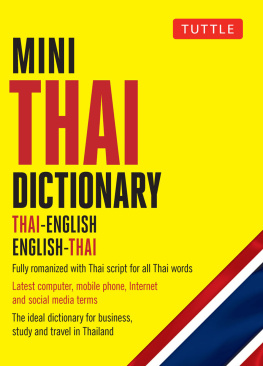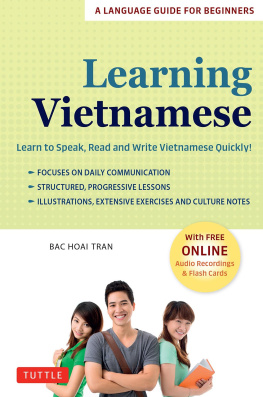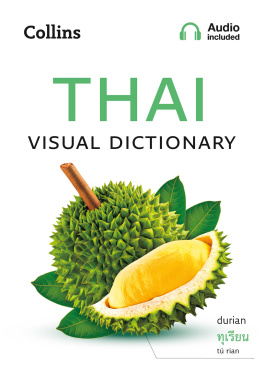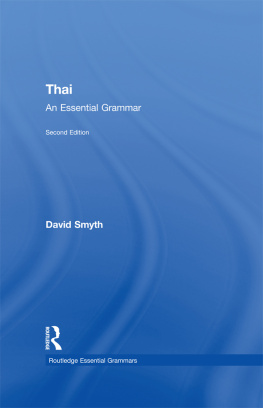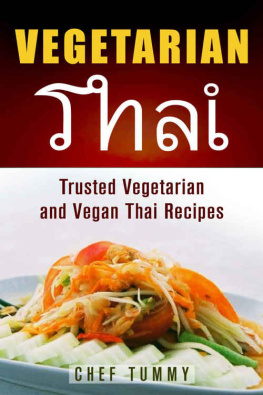READING & WRITING THAI
READING & WRITING THAI b y Jint ana R a t t anak hemak or n A WOR K B OOK F OR SELF - S T UD Y TU T T LE Publishing T okyo Rutland, V ermont Singapor e A Be ginner s Guide t o t he T hai Alphabe t and Pr onuncia t ion
C ontents Ho w t o U se This Book . Part One The Thai W r iting S ystem & Pr on unciation Introduction to the Thai Writing S y stem Part Two The Less ons Lesson 1: Consonan ts . Lesson 2: V o w els . Lesson 3: Ending Consonan ts . Lesson 4: T one Marks . Lesson 5: Consonan t Clust er s . Lesson 6: Irr egular R eading s . Lesson 7: R eading and W riting Thai W or ds . Lesson 8: R eading Thai Sen t enc es and Short P ar agr aphs . Do-It - Y our self . Quizz es . . W riting a P ar agr aph Part Three A ppendices Appendi x 1: Thai Basic P hr ases . Appendi x 2: Classier s . Appendi x 3: V eg etables . Appendi x 4: F ruits . Appendi x 5: D a y s and M on ths . Appendi x 6: T r ansport . Appendi x 7: W eigh t and length .
Ho w to U se This Book How to Use This Book Who is this book for? This book is an eas y t ouse guide for beginning-le v el learner s t o learn ho w t o r ead and writ e Thai withou t an y prior kno wledg e. It is designed for both self -study and use in a classr oom set - ting. The beginner can begin with the basics and then mo v e on t o in t ermedia t e lessons within the same book. What is the purpose of this book? The primary focus of this book is t o pr o vide s y st ema tic guidelines which tak e beginning learner s fr om tr acing and c op ying let t er s t o writing c omplet e w or ds and sen t enc es. P len t y of e x er cises and writing pr actic e ar e also included t o r einfor c e the lessons thr oughou t the book. How is the book structured? The c on t en t will be di vided in t o thr ee main parts: P art 1: An in tr oduction t o the basic Thai writing s y st em and pr on uncia tion guide using R omaniza tions t o help iden tify and pr onounc e e v ery Thai c onsonan t and v o w el. P art 2: The main body of the book c on tains 8 lessons which t each beginner s ho w t o writ e Thai c onsonan ts, v o w els and t one marks, and will build up t o writing and r eading w or ds, c omplet e sen t enc es, and short par agr aphs. The r st thr ee lessons will gi v e y ou st ep-b y -st ep guidelines on ho w t o writ e each char act er nea tly in the c orr ect str ok e or der , with g ener ous spac es pr o vided for handwriting pr actic e. Each lesson has a set of e x er cises for r e vie wing and r einfor cing y our abilit y t o r ead, writ e, and c ompr ehend Thai. P art 3: A nal r e vie w gi v es y ou additional pr actic e, and a t the end of the book a udio r ec or d - ing s and prin table ashcar ds will be pr o vided for do wnload. Appendic es a t the back also allo w y ou t o learn some of useful v ocabulary and English meaning s. Learning t o r ead and writ e a ne w languag e can be a challeng e as y ou need t o g o thr ough a fair amoun t of r ot e memoriza tion. Ho w e v er , this book c on tains e v erything t o help y ou bec ome c on - den t in r eading and writing Thai. The lessons will guide y ou and e xplain in detail ho w Thai writing s y st em w orks. Y ou ma y nd it easier than y ou e xpect aft er all.
The Thai Writing System & Pronunciation Part

Intr oduction t o th e Thai W riting S y s t em Introduction to the Thai Writing System The earliest Thai writing w as found in S ukhothai period, b y King Ramk amhaeng in 12 83. He de - vised The S ukhothai Script based on the ancien t Khmer and M on scripts, which w er e deri v ed fr om sou thern Indian scripts thr ough the spr ead of the Buddhist r eligion and tr ade c on tacts in Sou theast Asia. La t er in the early periods of the A yu t tha y a King dom, the script called King N ar ai script w as r eformed and has been used as the na tional Thai script up t o the pr esen t . Thai, lik e other Indian-based scripts, lists c onsonan ts and v o w els separ a t ely . The Thai script has v ery c omple x rules on ho w let t er s ar e pr onounc ed. Oft en, m ultiple let t er s r epr esen t the same sound. On the other hand, the sounds of man y Thai let t er s dier depending on whether the let t er oc cur s a t the start or the end of a s yllable. In Thai writing, s yllables, w or ds, and sen t enc es ar e writ t en and r ead fr om left t o righ t withou t in t erv ening spac es. V o w els can appear befor e, abo v e, aft er , or belo w a c onsonan t . The c onsonan t alw a y s sounds r st when pr onouncing or r eading the s yllable. In addition, ther e is no distinction bet w een upper case and lo w er case let t er s, and the end of a sen t enc e is mark ed b y a spac e. The ocial languag e of Thailand, kno wn as S tandar d Thai, is based on the languag e spok en in c en tr al Thailand. M ost people li ving in c en tr al part of Thailand use S tandar d Thai as their c ommon languag e, while people in the sou thern, northern, and northeast ern r egions ar e bilin - gual speak er s of S tandar d Thai and their r egional dialects. Basic Thai grammar Thai gr ammar is v ery eas y t o under stand when c omparing with w est ern languag es. Ho w e v er , ther e ar e some aspects tha t need t o be c onsider ed when cr ea ting sen t enc es. Dier en t pr onouns ar e used b y male and female speak er s. Ho w e v er , subject pr onouns and object pr onouns ar e the same (ther e s no dier enc e bet w een I and me or he/ she and him/ her). The c ommonly used per sonal pr onouns ar e: English Pronoun Thai Pronoun I, me (for male speak er s) phm I, me (for female speak er s) chn y ou (polit e) khun he, she, the y kho w e, us rao No t e : In casual c on v er sa tion, it s v ery c ommon tha t subjects ar e oft en omit t ed, especially I and Y ou . Also , r a ther than using a per sonal pr onoun, a nickname is oft en used t o r efer t o y our self or the thir d per son. Ther e ar e no articles lik e a , an , and the. W or ds ar e ne v er modied or c onjug a t ed for t ense, per son, possession, singular / plur al, g ender , or subject - v erb agr eemen t . Thai sen t enc es follo w the same subject - v erb-object w or d or der as in English. N o punctua tion is used t o indica t e a question or the end of a Thai sen t enc e. In or der t o form a question, y ou add a question w or d a t the end of the sen t enc e.

Intr oduction to th e Thai W riting S y s tem khun hw mi Are y ou h ungry? khun tha m-aa-han -rai Wha t ar e y ou c ooking? When talking abou t quan tities of thing s, y ou need t o add a classier , similar t o four sheets of paper or thr ee bot tles of wine in English. In Thai ho w e v er , the n umber and classier c ome aft er the noun. noun + number + classier paper + four + sheets gr-dat si phehn = four sheets of paper wine + thr ee + bot tles waay sam khat = thr ee bot tles of wine T enses ar e indica t ed mostly b y using a timefr ame or helping w or ds a t the beginning of or the end of a sen t enc e. In or der t o sta t e the past and the fu tur e in Thai, y ou can use the follo wing optional w or ds. U sing time w or ds, such as no w , today , y e s ter day , tom orr ow , six o c loc k , et c. F or e x ample, Meah-waan-ni chn pai wt I w en t t o the t emple y est er da y . W an-ni chn neay I feel tir ed t oda y . U sing lew ( alr eady) a t the v ery end of a sen t enc e t o indica t e tha t something w as c omplet ed befor e or prior t o the momen t of speaking. F or e x ample, Chn gin yaa lew I v e alr eady tak en medicine. Phm ap-nm lew . I v e alr eady tak en a ba th. U sing j (will) in fr on t of v erbs t o indica t e the fu tur e, and sometimes y ou can also include a time w or d t o emphasiz e when it is g oing t o happen in the fu tur e. F or e x ample, chn j pai t-lat I will g o t o the mark et . Duean-na khun j tham--rai? Wha t will y ou do ne x t mon th?

